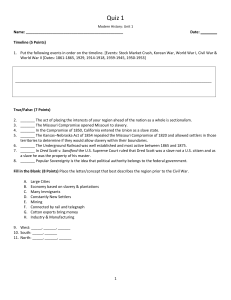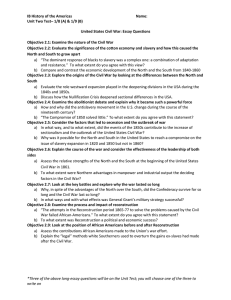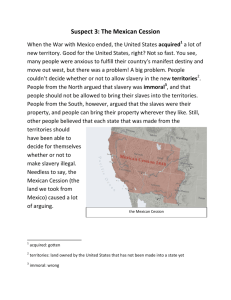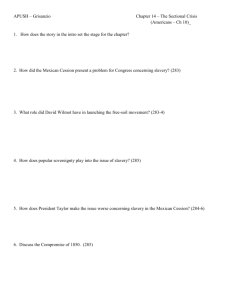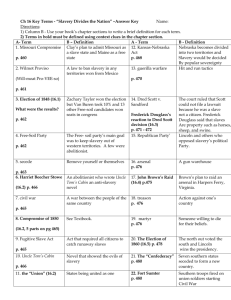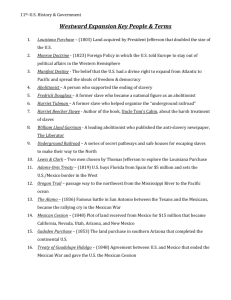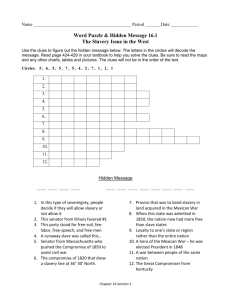1844-1877 - APUSH Home Page
advertisement
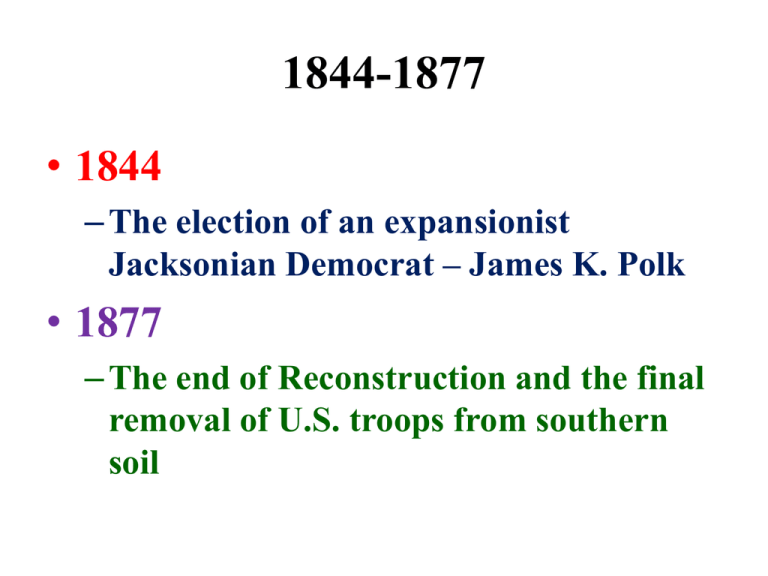
1844-1877 • 1844 – The election of an expansionist Jacksonian Democrat – James K. Polk • 1877 – The end of Reconstruction and the final removal of U.S. troops from southern soil Getting to know the 1844-1877 Time Period • • • • • • • • Battle of Gettysburg Kansas-Nebraska Act Gold Rush begins Uncle Tom’s Cabin published Sand Creek Massacre Homestead Act Emancipation Proclamation issued John Brown’s Raid • • • • • • • Mexican War begins Gadsden Purchase Election of Lincoln Compromise of 1850 Reconstruction Acts Battle of Little Bighorn Birth of the Republican Party • Dred Scott Decision Getting to know the 1844-1877 Time Period • • • • • • • • Mexican War begins (1846) Gold Rush begins (1849) Compromise of 1850 Uncle Tom’s Cabin published (1852) Gadsden Purchase (1853) Kansas-Nebraska Act (1854) Birth of Republican Party (1854) Dred Scott Decision (1857) • • • • • • • • John Brown’s Raid (1859) Election of Lincoln (1860) Homestead Act (1862) Emancipation Proclamation (1862) Battle of Gettysburg (1863) Sand Creek Massacre (1864) Reconstruction Acts (1867) Battle of Little Bighorn (1876) American Westward Expansion • Fueled by – Economic interests – expanding the market economy (new places to sell to and buy from) – National security interests – controlling the natives and protecting American settlers • Justified by – Claims of white racial superiority – Claims of American cultural superiority (Manifest Destiny) American Westward Expansion • Led to – War with the natives and with Mexico – New markets on the continent and in Asia – New States/Territory – Political conflicts over the spread of slavery within the U.S. MANIFEST DESTINY! • A continuation of the belief that God has blessed America, we are a city upon a hill, and that God is pleased with American institutions (freedom and democracy) MANIFEST DESTINY! • From Jefferson (1801) to the end of Jackson’s presidency (1837), 10 new states were added to the Union. • • • • Ohio 1803 Louisiana 1812 Indiana 1816 Mississippi 1817 • • • • • • Illinois 1818 Alabama 1819 Maine 1820 Missouri 1821 Arkansas 1836 Michigan 1837 MANIFEST DESTINY! –Americans had settled in Texas and by 1836 led a successful revolution against the Mexican Government –Americans had made their way on trails west to California and by the 1840’s were stirring up a revolt against the Mexican government there The Election of James K. Polk in 1844 • Led to –Settling the Oregon dispute with England (Pacific Northwest) –Florida Statehood –The annexation of Texas (which actually happened 3 days before his inauguration) –War with Mexico and the acquisition of the Mexican Cession James K. Polk The Mexican War (1846-48) • Started over a boundary dispute between Texas (after it became a state) and Mexico • Controversial beginning (Historical interpretation) – Some historians argue that President Polk provoked the war (by sending troops to the disputed land) so we could take Mexican land – Other historians argue that Polk was justly defending U.S. territory POLK’S MESSAGE ON WAR WITH MEXICO • May 11, 1846 • “…Mexico has passed the boundary of the United States, has invaded our territory and shed American blood upon the American soil.” The Treaty of Guadalupe-Hidalgo (1848) • U.S. acquired over 500,000 square miles of Mexican land – The Mexican Cession (California, Arizona, New Mexico, parts of Utah and Colorado) • Mexico recognized Texas independence and the Rio Grande as its southern boundary • The U.S. paid Mexico $15 million The Wilmot Proviso (1846) • During the war, a proposal was made to prevent slavery from spreading into a new lands we may acquire • The Wilmot Proviso did not become law but it set the stage for further tensions over the spread of slavery ANTI-SLAVERY • Had been a growing sentiment in the north (DIFFERENT AND MORE COMMON than abolitionism) • Any lands acquired through westward expansion should be open only to free men (1846 Wilmot Proviso reflected this belief) ANTI-SLAVERY • Free men should not have to compete against slave labor for economic opportunities • Free men, free soil, free labor • The Free Soil Party nominated former president Van Buren in 1848 ANTI-SLAVERY • Slavery could exist where it had traditionally existed • This was the ideology of the Free Soil party and eventually the Republican Party • This is NOT abolitionism • Anti-slavery sentiment is anti the SPREAD of slavery The Controversy of 1850 • Should California (part of the Mexican Cession) be allowed to enter the Union as a free state? • What about the spread of slavery into the rest of the Mexican Cession? THE COMPROMISE OF 1850 • California entered the union as a free state • The rest of the Mexican Cession was divided into two territories where popular sovereignty would determine the slave issue THE COMPROMISE OF 1850 • The slave trade in Washington, D.C. was abolished • A tough new fugitive slave law was passed UNCLE TOM’S CABIN (1852) • Harriet Beecher Stowe • Written in response to the fugitive slave law UNCLE TOM’S CABIN (1852) • Melodramatic story of a devout Christian slave (Uncle Tom) who is brutalized for refusing to whip another slave • A desperate mother (Eliza) runs away with her child rather than having him sold to pay off her masters debt UNCLE TOM’S CABIN (1852) • Pulls the heart-strings of readers • Points out hypocrisy of Christians that do not condemn slavery • Stirs up anti-slavery sentiment in the north THE KANSAS-NEBRASKA ACT (1854) • Stephen Douglas, Democratic senator from Illinois • Wants a proposed transcontinental RR to run through Chicago for the economic benefits • Needs southern support because the RR would lead to populating the northern L.P. territory THE KANSAS-NEBRASKA ACT (1854) • Organized the northern L.P. land into two territories: Kansas and Nebraska • Opened the territories to popular sovereignty and therefore REPEALED THE MISSOURI COMPROMISE!!!! • Douglas felt this would give him southern support for a northern RR • He also felt Kansas and Nebraska would end up being free IMPACT OF THE K-N ACT • Angry northerners, some Dems, some Whigs, some Free Soilers eventually organize into an anti-slavery political party: The Republican Party • The Kansas territory became a testing ground for popular sovereignty IMPACT OF THE K-N ACT • Anti-slave and pro-slave settlers moved into Kansas • This is where John Brown takes the stage of American history James Buchanan (1857-1861) THE DRED SCOTT DECISION (1857) • Scott belonged to an army surgeon and lived in Illinois and the Wisconsin Territory for an extended time (7 years) where slavery was prohibited THE DRED SCOTT DECISION (1857) • This gave him the basis for suing in a Missouri (his new home) court for his freedom THE 1857 LANDMARK DECISION (Dred Scott) • 7 of the 9 Supreme Court justices had been appointed by pro-slavery southern presidents • 5 were from slaveholding families including the Chief Justice, Roger B. Taney THE 1857 LANDMARK DECISION • The Court Ruled – Slaves were not citizens therefore Scott had no right to sue in the first place – The Missouri Compromise of 1820 was UNCONSTITUTIONAL because it denied U.S. citizens the right to property (protected in the 5th Amendment to the Constitution) – Therefore, the federal government could not restrict the spread of slavery!!! THE 1857 LANDMARK DECISION • Slaves were “a subordinate and inferior class of beings, who had been subjugated by the dominant race…and had no rights or privileges but such as those who held the power and the Government might choose to grant them.” IMPACT OF THE DRED SCOTT DECISION • Outraged abolitionists and antislavery northerners • Appeared to them as evidence that there was a slave power conspiracy within the federal government • Greatly increased the tensions in the country on the heels of Bleeding Kansas John Brown’s Raid • October 1859 • Harper’s Ferry, Virginia (today it’s in West Virginia) THE ELECTI0N OF 1860 Secession Crisis (1860-1861) • Between Lincoln’s election (November 6, 1860) and his inauguration (March 4, 1861), 7 southern states voted to secede from the U.S. • SC, GA, FL, AL, MS, LA, TX • Last minute attempts at compromise failed (Crittendon Compromise and a proposed 13th Amendment to protect slavery) CAUSES OF THE CIVIL WAR • Breakdown of the balanced second party system of the Age of Jackson (Dems and Whigs) and the emergence of sectional political parties (Dems and Republicans) in the 1850’s • The industrialization and urbanization of the North while the South remained based on slave agriculture CAUSES OF THE CIVIL WAR • Rising anti-slavery sentiment in the North • A vocal abolitionist movement – American ideals conflicting with American realities • The ongoing debate over federal government power vs. state power: States’ Rights CAUSES OF THE CIVIL WAR • Southern perception of Northern intentions (John Brown Republicans) vs. Northern perception of a slave power conspiracy in the federal government (past presidents, Dred Scott) CAUSES OF THE CIVIL WAR • The immediate spark was the election of a Republican in 1860 • Many southerners concluded they no longer had a voice in the federal government The Civil War (1861-1865) • Reviewed Tindall 16 and 17 quiz • Video – John Brown – The Higher Object – New Birth of Freedom – Lincoln’s Second Inaugural Address – The Lincoln Assassination – from the Conspirator (You Tube) Sullivan Ballou Letter Why Did the Northern States defeat the Secessionists? • Manpower and resources advantage – 85/15; Better able to replace the dead and wounded • The Emancipation Proclamation prevented recognition of the CSA by changing the purpose of the war • Both CSA invasions into the USA failed (Antietam in 1862, Gettysburg in 1863) • Southern resources and environment destroyed by the invading Northern army The Civil War in Perspective • 600,000 Americans died in the Civil War • Out of a total population of about 31 million • This represented about 2% of the total U.S. population • A war like that today would result in the death of • OVER 6 MILLION AMERICANS RECONSTRUCTION 1865-1877 • 3 PHASES – PRESIDENTIAL RECONSTRUCTION • 1865-1866 • SOUTHERN STATES MEET LENIENT LINCOLN/JOHNSON REQUIREMENTS TO REJOIN THE UNION • SOUTHERN STATES SUPPRESS FREE BLACKS (BLACK CODES) Mississippi Black Codes • Website Page 3 RECONSTRUCTION 1865-1877 – CONGRESSIONAL/MILITARY/RADICAL RECONSTRUCTION • 1867 to (Varies state by state) • CONGRESS FORCES CHANGE ON THE SOUTHERN PEOPLE – BLACKS, SOUTHERN REPUBLICANS (SCALAWAGS), AND TRANSPLANTED NORTHERN REPUBLICANS (CARPETBAGGERS) VOTE, HOLD OFFICE, WIELD POWER (temporarily) RECONSTRUCTION 1865-1877 • REDEMPTION – AS EARLY AS 1868 AND AS LATE AS 1877 (VARIES STATE BY STATE) – SOUTHERN WHITES REGAIN CONTROL OF THEIR STATE GOVERNMENTS (Redeemer Governments) – WHEN ALL THE EX-CONFEDERATE STATES RETURN TO WHITE SOUTHERN CONTROL, AND ALL UNION TROOPS ARE REMOVED FROM THE SOUTH, RECONSTRUCTION ENDS (1877) Short Term Successes of Reconstruction • Re-united the United States • Provided political opportunities for black Americans (during the Radical phase) • Temporarily rearranged the relationships between blacks and whites in the South (during the Radical phase) • The federal government used its authority to protect the individual rights of the ex-slave (during the Radical phase) • The Constitution was dramatically changed with the 13th, 14th, and 15th Amendments 13th Amendment • Abolished slavery everywhere in the U.S.!! • Neither slavery nor involuntary servitude, except as a punishment for crime whereof the party shall have been duly convicted, shall exist within the United States, or any place subject to their jurisdiction. 14th Amendment • Took the main provisions of the Civil Rights Act of 1866 and enshrined them into the Constitution • Made anyone born on U.S. soil a citizen (designed to make ex-slaves citizens) • 1st and only mention of EQUALITY in the Constitution (Equal Protection Clause) The 14th Amendment (1868) • All persons born or naturalized in the United States, and subject to the jurisdiction thereof, are citizens of the United States • No State shall deny to any person within its jurisdiction the equal protection of the laws. Eric Foner on Reconstruction • Foner video on the 14th Amendment 15th Amendment • Provided for black male suffrage • The right of citizens of the United States to vote shall not be denied or abridged by the United States or by any State on account of race, color, or previous condition of servitude In What Ways was Reconstruction a Failure? • In the end, it did not change Southern attitudes or culture (white supremacy remained) • After Radical Reconstruction, the Republican Party did not take hold in the South – The South remained solidly Democratic (The Solid South) In What Ways was Reconstruction a Failure? • After Radical Reconstruction, the federal government stopped using its authority to ensure that all Americans received equal protection under the law • Ex-slaves remained property less and tied to the land of white southerners (Sharecropping) • Foner video
